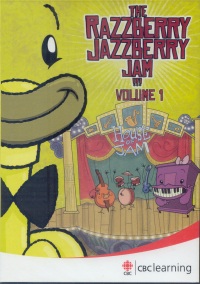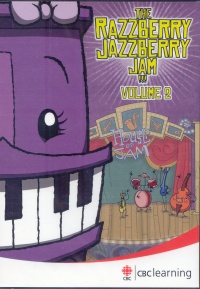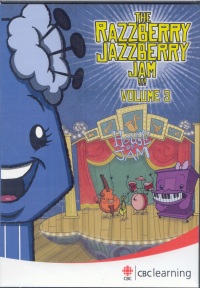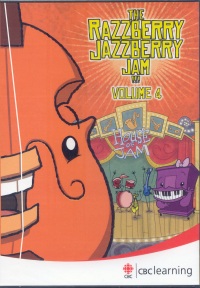| ________________
CM . . .
. Volume XVIII Number 40. . . .June 15, 2012

 |
The Razzberry Jazzberry Jam. Volume 1: Move to the Beat.
Toronto, ON: CBC Learning (www.cbclearning.ca), 2009.
88 min., DVD, $75.00 (Single site license price).
Product ID ZYX-09-02.
Kindergarten-grade 3 / Ages 5-8.
Review by Barbara Taylor & Karen Cooper.
**½ /4
|
| |
|
 |
The Razzberry Jazzberry Jam. Volume 2: Join the Jam.
Toronto, ON: CBC Learning (www.cbclearning.ca), 2009.
66 min., DVD, $75.00 (Single site license price).
Product ID ZYK-09-03.
Kindergarten-grade 3 / Ages 5-8.
Review by Barbara Taylor & Karen Cooper.
**½ /4
|
| |
|
 |
The Razzberry Jazzberry Jam. Volume 3: For our Fans.
Toronto, ON: CBC Learning (www.cbclearning.ca), 2009.
66 min., DVD, $75.00 (Single site license price).
Product ID ZYX-09-04.
Kindergarten-grade 3 / Ages 5-8.
Review by Barbara Taylor & Karen Cooper.
**½ /4
|
| |
|
 |
The Razzberry Jazzberry Jam. Volume 4: Snap My Strings.
Toronto, ON: CBC Learning (www.cbclearning.ca), 2009.
66 min., DVDs, $75.00 (Single site license price).
Product ID ZYX-09-05.
Kindergarten-grade 3 / Ages 5-8.
Review by Barbara Taylor & Karen Cooper.
**½ /4
|
| |
|

CBC Learning has produced a four volume DVD series for a Kindergarten-grade 3 music program based on its children’s TV series “Razzberry Jazzberry Jam”.
In the first DVD, we are introduced to the cartoon characters Louis, the Trumpet as the bandleader, Ella, the Piano who acts as the “band’s emotional center, the diplomat and ambassador, Billie, the Guitar who is the band’s diva, RC, the Double Bass who is the most laid-back member of the band, while Buddy and Krupa, the Drums, are sibling rivals who frequently clash in temperament.
The series aims to promote good social values while teaching fundamental music concepts. The 22-minute cartoon episodes are fast-paced and will appeal to young children who like the “Sponge Bob” style cartoon characters with bright colours and stick-like arms and legs. There is plenty of action as characters tumble up and down stairs and into each other, race in and out of rooms and, of course, jam together. True to the title of this series, the music is predominantly Jazz. There is very little sing-a-long material.
The jazz theme fits in with the idea of letting children have the freedom to explore and experiment with music and instruments. Those teachers looking for more direct instruction about musical theory will be disappointed.
There is an Educator’s guide with the DVD series that gives good suggestions for musical activities to include with each episode. This guide can function as a stand-alone resource with or without the accompanying DVD. This makes it a good resource for those teachers, or substitute teachers that have little musical background and are called on to put together a music class.
Volume 1: Move to the Beat (Beat): Tempo Trouble (Tempo); Sold on the Slide (Solo); Happy Birthday House (Dynamics).
The first volume of the DVD series, Move to the Beat, includes four episodes. The musical themes include: beat, tempo, solo and dynamics. The musical instruments featured in the school clips are a sousaphone, violin, steel guitar and bagpipes.
In episode one, the characters are marching to the beat; however, Ella the Piano is left behind because she has wheels and can’t march up and down stairs. The second episode explores the musical concepts of tempo by focusing on Billie the Guitar who dances so quickly no one can keep up with her. The following two episodes, Solo on the Slide (concept: Solos) and Happy Birthday House (concept: Dynamics), follow the same pattern of blending social and musical concepts.
It was hard to define what the episodes were “about”. There is a heavy emphasis on social mores, such as co-operation inclusion and friendship. The “music lesson” is overshadowed by the social message.
Each program features a couple of clips (about 5 minutes total) of a music lesson in a Toronto area school (different schools in each show) where a musician introduces the featured instrument to a group of 10-15 young children (kindergarten/grade one). The children are given the opportunity to explore aspects of the instrument by blowing in mouthpieces, marching while playing instruments, etc. These are probably the most informative curricular-relevant segments of each show.
Our school’s music specialist viewed the DVD series and thought they were fun, but not appropriate as a “music program”. I found it hard to grasp the main concepts of the episodes as the social concepts seemed to overshadow the musical concepts.
The students we shared segments of the program with had their own views. The Grade One students thought the show was great and were able to identify both the social and musical concepts expressed in the first episode. The grade 2/3 students watched the episode quietly, grasped the concepts being introduced, but were split over the age appropriateness of the series. Most felt it was for a kindergarten or grade one audience.
This would be a good resource for substitute teachers, particularly those with little music background, to use as a quick lesson for pre-kindergarten to grade 2 classes.
Volume 2: Join the Jam: Melody Makers (Melody), Billie’s Biggest Fan (Inclusiveness); Super Sounds (Texture).
Volume 2: Join the Jam features three episodes of the CBC learning program Razzberry Jazzberry Jam. The program attempts to combine social and musical concepts in a Saturday morning cartoon format. It is bright, colourful, fast-paced, and will keep young children entertained (see review section for Volume One).
Volume 2 contains three episodes that follow the same formula as Volume 1. The characters; Louis, the Trumpet; Ella, the Piano, Billie, the Guitar, RC, the Double Bass, Buddy and Krupa, the Drums, as well as visiting instruments, tackle the social issues of inclusiveness and open-mindedness while introducing the musical concepts of melody, rhythm and texture.
This series is most appealing to a pre-kindergarten through grade two audience, but the creators have built storylines in the first two episodes that might confuse younger audiences.
In the first episode, during a get-together on the character’s apartment roof-top, a Xylophone is devastated when a wind gust blows some of his keys into the apartment’s ventilation system. I’m not sure how familiar young children are with ventilation systems. The second episode features Billie, the diva guitar, and her greatest fan, which is a fan. Again, I’m not sure young children will grasp the double meaning.
The three action packed and entertaining episodes are interspersed with clips of a musician visiting a Toronto area school introducing new instruments to the children.
While this series and supporting material shouldn’t be considered a “music program”, these materials could be used as an occasional support and can allow a substitute teacher or teacher with little musical background to put together a quick lesson.
Volume 3: For our Fans: Give it a Rest (Rest); Forever Song (Form); Phantom of the Jam (Expression).
In Volume 3 of the CBC learning series The Razzberry Jazzberry Jam, the audience is introduced to the concepts of tempo, dynamics repetition, form and sound effects with the featured instrument guests being the cymbals, harmonica and handsaw. The social concepts accompanying the musical concepts stress the need for resting, structure, and emotional expression.
The same formula of cartoon segments followed by live school-based performance and teaching clips is used throughout the series.
The Teacher Resource Guide gives excellent hands-on activities to reinforce the concepts in each volume.
Unit 8 explores the concepts of “rest” to accompany the first program in this volume, “Give it a Rest”. The activities used to emphasize the “rest” are commonly known games, such as musical chairs wherein the “rest” in the music means scrambling for a chair.
Unit 9 explores the “Frame” of a song and accompanies the second program, “Forever Song”. The first activity has the instructor comparing the creation of a song to building a sandwich:
Show or illustrate a slice of bread on which two slices of cheese are place, and then the sandwich is completed with a second slice of bread.
By singing Twinkle, Twinkle Little Star this comparison will come to life:
Bread #1: Twinkle, Twinkle Little Star, how I wonder what you are?
Cheese #1: Up upon the world so high.
Cheese #2: Like a diamond in the sky.
Bread #2: Twinkle, Twinkle Little Star, how I wonder what you are?
In Unit 10, Phantom of the Jam, instructions are given for making simple drums that the children can use in a drumming circle.
The activities and lessons given in the Teaching Resource Guide are basic, easy to put together and, as we have mentioned before, a great resource for substitute teachers or teachers with little music teaching background.
Volume 4: Snap My Strings: A Bonnie Tale (Improvisation); Join the Jam (Inclusiveness); Tuning In (Tuning).
This is the final volume in the Razzberry Jazzberry Jam series aimed at educating children about musical and social concepts while entertaining them with the cartoon antics of Louis the Trumpet, Ella the Piano, Billie the Guitar, RC the Double Bass, and the Drum brothers Buddy and Krupa.
Each episode introduces a musical concept, a guest instrument, and a social problem, in a fast paced, action-packed cartoon interspersed with clips of musical instruction in an elementary school classroom. While mixing musical and social concepts tends to take away from the focus of teaching musical concepts, the Teacher Resource Guide provides good ideas for teachers with limited musical training.
In episode 11, the first episode in Volume 4, Bonita the clarinet, who is classically trained, replaces her brother Woody, who likes to improvise, on a visit to play with Jazzberries. Problems ensue because of Bonita’s inflexibility. The social problems of having a classical musician in a jazz band blend with teaching different styles of playing music.
Episode 12 emphasizes the problems that happen when members of the ensemble stop working together, while the final episode emphasizes the need to be “in tune” as an instrument as well as a group participant.
Recommended.
Barbara Taylor is a School Librarian and Karen Cooper is a School Music Specialist at St. Boniface School in Calgary, AB.

To comment
on this title or this review, send mail to cm@umanitoba.ca.
Copyright © the Manitoba Library Association. Reproduction for personal
use is permitted only if this copyright notice is maintained. Any
other reproduction is prohibited without permission.
NEXT REVIEW | TABLE OF CONTENTS FOR THIS ISSUE
- June 15, 2012.
AUTHORS | TITLES | MEDIA REVIEWS | PROFILES | BACK ISSUES | SEARCH | CMARCHIVE | HOME
|



